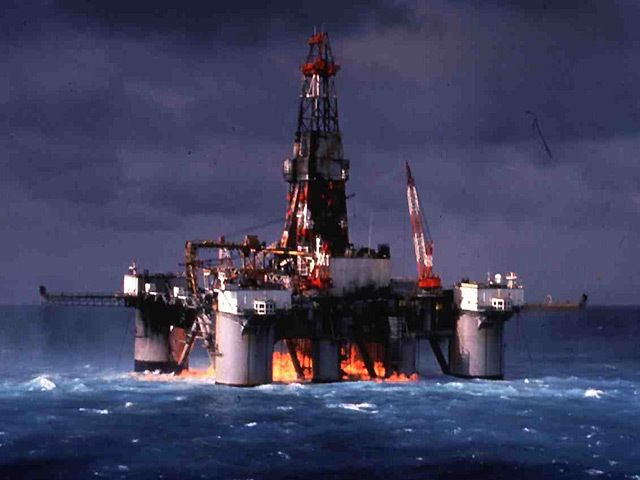
On September 22, 1988, just over two months after the Piper Alpha disaster that killed 167 offshore workers, the rig Ocean Odyssey came within a hair’s breadth of being blown to pieces.
The Odeco rig was just five years old when it set its bit into drilling exploration well 22/30b- 3 in the Central Graben of the North Sea for client, the American company Arco.
By September 21 an 8.5 inch hole had been drilled to 4,925m (16,160ft); but drilling had been curtailed as the crew attempted to cure severe drilling fluid losses into the sedimentary formation deep below.
It was around 05.30 on the morning of the following day, with limited drilling mud and barite supplies left and apparently against the judgement of others on board, the Arco representatives chose to pull out of the hole to try and regain circulation.
Up to 70 barrels were gained by 09.00 hours as the bit was tripped out to 4,023m (13,200ft), at which point it seems the Arco rep decided to stop and circulate. Subsequent gains led to attempts at well control via the choke.
At around 11.30, a sharp rise in casing pressure was seen, with substantial mud returns and there was gas vapour present at the drill-floor’s rotary table.
With the bit at 4,023m the circulating pressure was not great enough to prevent a gas influx into the well and the well began to flow.
The control room operator was then alerted to a gas kick and all rig crew were ordered to lifeboat stations as a precautionary measure.
At around 12.55 the first explosion occurred and the four remaining crew on the drill-floor evacuated to lifeboats.
The well was not shut in completely with the lower rams. A few minutes later, at about 13.05, there was catastrophic choke hose failure due to the uncontrolled flow of aggressive fluids.
This led to the release of large quantities of gas and caused fires both on the rig and on the surface of the sea beneath the rig.
At some point between mustering at the lifeboats at 11.30 and the first explosion at 12.55, the off-duty radio operator was ordered by the OIM (offshore installation manager) to leave his lifeboat and return to the radio room to continue communications. That decision proved fatal.
Timothy Williams subsequently died from the effects of smoke and fire at around 13.20 hours in the pilot house, while trying to evacuate the rig. He was just 25 years old.
Of the 67 crew on board, 58 were evacuated by enclosed lifeboat with eight others jumping directly into the sea after missing the launching of the lifeboats, where they were picked up by fast rescue craft from the Notts Forest, the Odyssey’s stand-by vessel.
Crew members in the lifeboats reported waiting with the boat hatches open for the remainder of the crew until the first explosion occurred and boat launching began.
The four drill-floor crew arrived at the boats at this point and jumped in through the hatches of the boats, just as the survival-suited occupants were frantically trying to close the hatches as a wall of fire approached.
It was the legendary fire-fighter Red Adair, fresh from handling the Piper Alpha conflagration, who was called in to extinguish the blaze aboard the Odyssey,
At the subsequent fatal accident inquiry held at Aberdeen’s sheriff court, both the OIM’s and Arco’s (Atlantic Richfield) handling of the incident was censured.
The inquiry recorded: “The death of Timothy Williams might reasonably have been prevented (i) if the Offshore Installation Manager (OIM) had not ordered him from the lifeboat to the radio room; (ii) if the OIM, having ordered Timothy Williams back to the radio room, had countermanded that order when the rig was evacuated, and taken steps to see that the countermanding order was communicated to him.”
The inquiry also concluded that the Arco representatives had not followed safe and correct drilling practices in the management of the well, which included failing to correctly identify shut-in drill-pipe pressure, failing to correctly calculate the circulation time of the gas kick and failing to shut in the well once the well began flowing uncontrollably.
For a number of years after the Odyssey accident, the UK Department of Energy effectively banned drilling in areas with anticipated reservoir pressures in excess of 10,000psi.
Completed in March 1983 by Sumitomo Heavy Industries in Japan for Odeco, the Ocean Odyssey was in fact one of the most advanced semi-subs of its day.
After the fire, the Odyssey sat in the Tay at Dundee for a considerable period before being sold to become an ocean-going satellite launch pad called Sea Launch by a joint four-company consortium which included Boeing and Kvaerner. Sea Launch is based at Long Beach and continues to deliver vehicles into space.
As for the survivors of the Ocean Odyssey debacle, they were collectively offered some £6million in compensation on October 18, 1992, via an out-of-court settlement reached with the rig’s owners.